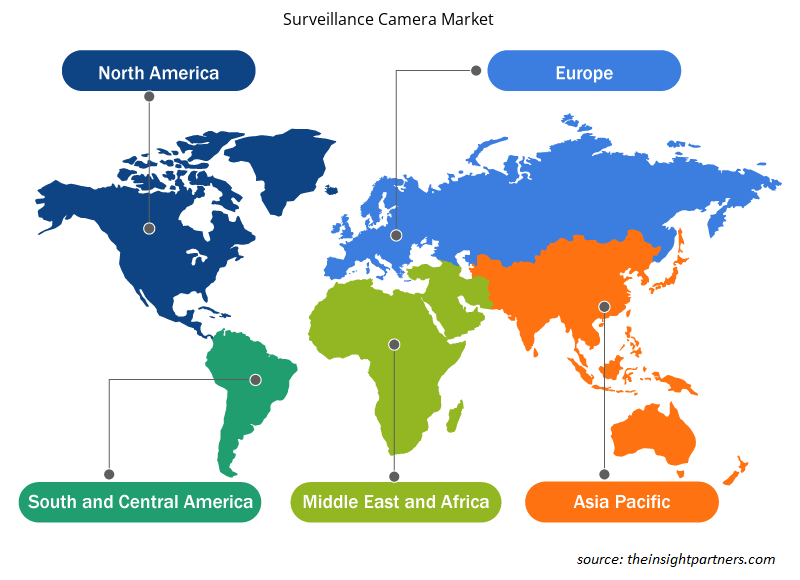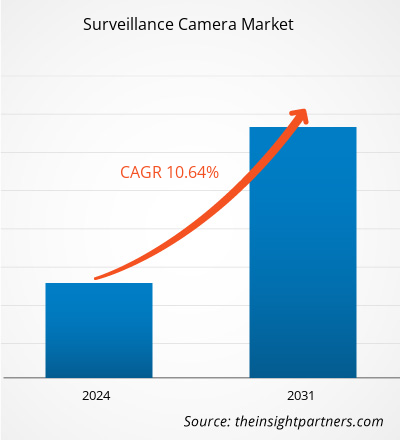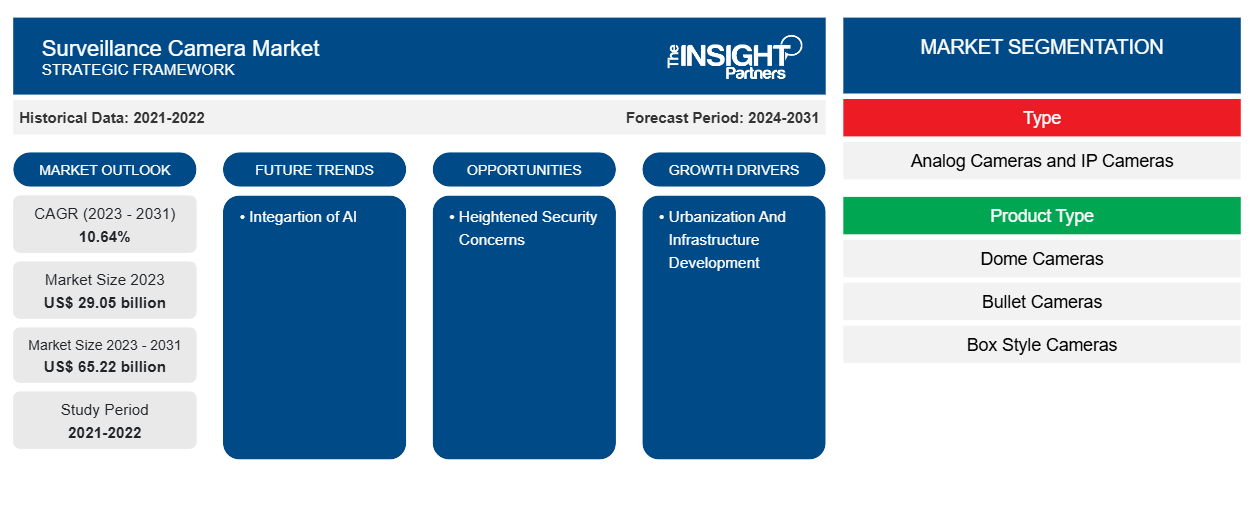監視カメラ市場規模は、2023年の290.5億米ドルから2031年には652.2億米ドルに達すると予測されています。市場は2023年から2031年にかけて10.64%のCAGRを記録すると予想されています。セキュリティに対する懸念の高まりが、世界の監視カメラ市場を牽引しています。CAGR of 10.64% in 2023–2031. The growing security concern drives the global surveillance camera market.
監視カメラ市場分析
監視カメラのネットワーク全体は、特定の施設を監視および制御するために使用される閉回路システムで構成されています。これらのカメラは、多くの場合、監視カメラをリモート ロケーションからメイン ロケーションに接続する IP (インターネット プロトコル) ネットワークで動作します。監視カメラまたはセキュリティ カメラは、録画したビデオを単一の PoE ケーブルを介してデジタル信号の形で NVR (ネットワーク ビデオ レコーダー) に送信します。これにより、電源ケーブルが不要になります。
監視カメラ市場の概要
監視カメラは、設置されているエリアを監視するカメラです。これらはセキュリティ システムと連動して動作します。これらのカメラは、セキュリティを確保し、犯罪行為を抑止するために、オフィス、自宅、小売店、または公共の場所に設置できます。これらのカメラで記録された映像は、犯罪が発生した場合の証拠としても使用されます。さまざまな機能を備えたさまざまな種類のセキュリティ カメラがあります。監視カメラは、特定のエリアを監視し、望ましくない状況を制御するためだけに使用するのが適しています。監視カメラは、犯罪行為が発生したときに当局に警告するように設計されています。それらは AI と統合されていますが、セキュリティ カメラは映像を記録するカメラにすぎません。
要件に合わせてレポートをカスタマイズする
このレポートの一部、国レベルの分析、Excelデータパックなど、あらゆるレポートを無料でカスタマイズできます。また、スタートアップや大学向けのお得なオファーや割引もご利用いただけます。
-
このレポートの主要な市場動向を入手してください。この無料サンプルには、市場動向から見積もりや予測に至るまでのデータ分析が含まれます。
監視カメラ市場の推進要因と機会
都市化とインフラ整備が市場に有利に働く
監視技術は、都市インフラとサービスの最適化において重要な役割を果たします。センサーとカメラは、交通管理、エネルギー消費の最適化、廃棄物管理、およびより優れた交通システムの開発を支援するデータを提供します。これらの洞察は情報に基づいた都市計画を促進し、資源効率が高く持続可能な都市につながります。さらに、スマートシティの統合監視カメラシステムは、居住者の安全とセキュリティを確保する比類のない機能を提供します。リアルタイム監視により、緊急事態への迅速な対応、異常のタイムリーな検出、イベントや危機時の効果的な群衆管理が容易になります。このように、都市化とインフラ開発は監視カメラ市場の成長を促進しています。
セキュリティ上の懸念の高まり
公共の安全上の懸念から、カメラ、ビデオ監視システム、相互運用性プラットフォームへの注目がかつてないほど高まっています。カメラの設置やビデオ監視システムの強化を優先して争う動きは、かつてないほど高まっています。さまざまな国がセキュリティ目的で監視カメラを導入しています。たとえば、2024年2月には、ロシアのウクライナへの本格的な侵攻が2年の節目に近づく中、ウクライナ全土の政府運営のセキュリティシステム、住宅、民間企業で使用されている中国製のHikvisionとDahuaのビデオ監視カメラ数十万台が、ロシア軍による攻撃のリスクを高めていると、ウクライナのデジタルセキュリティの専門家や政府関係者は懸念しています。このように、セキュリティ上の懸念が高まると、監視カメラ市場の成長の機会が生まれます。
監視カメラ市場レポートのセグメンテーション分析
監視カメラ市場分析の導出に貢献した主要なセグメントは、タイプ、製品タイプ、およびエンドユーザーです。
- 監視カメラ市場は、種類別にアナログカメラと IP カメラに分類されます。
- 製品タイプに基づいて、監視カメラ市場は、ドームカメラ、バレットカメラ、ボックス型カメラ、PTZカメラ、サーマルカメラなどに分類されます。
- エンドユーザーに基づいて、監視カメラ市場は、BFSI、政府および防衛、商業、製造および建設、ヘルスケア、物流および輸送、住宅、その他に分類されます。
地域別監視カメラ市場シェア分析
監視カメラ市場レポートの地理的範囲は、主に北米、アジア太平洋、ヨーロッパ、中東およびアフリカ、南米/中南米の 5 つの地域に分かれています。北米には監視カメラのさまざまなプロバイダーがあり、そのプレーヤーは CCTV Security Pro などです。さらに、米国は厳しい監視下にあります。アトランタだけでも、住民 1,000 人あたり 50 台の CCTV カメラがあります。したがって、このような事例が監視カメラ市場の成長を牽引しています。
監視カメラ市場の地域別分析
予測期間を通じて監視カメラ市場に影響を与える地域的な傾向と要因は、Insight Partners のアナリストによって徹底的に説明されています。このセクションでは、北米、ヨーロッパ、アジア太平洋、中東、アフリカ、南米、中米にわたる監視カメラ市場のセグメントと地理についても説明します。

- 監視カメラ市場の地域別データを入手
監視カメラ市場レポートの範囲
| レポート属性 | 詳細 |
|---|---|
| 2023年の市場規模 | 290.5億米ドル |
| 2031年までの市場規模 | 652.2億米ドル |
| 世界のCAGR(2023年~2031年) | 10.64% |
| 履歴データ | 2021-2022 |
| 予測期間 | 2024-2031 |
| 対象セグメント |
タイプ別
|
| 対象地域と国 |
北米
|
| 市場リーダーと主要企業プロフィール |
|
市場プレーヤーの密度:ビジネスダイナミクスへの影響を理解する
監視カメラ市場は、消費者の嗜好の変化、技術の進歩、製品の利点に対する認識の高まりなどの要因により、エンドユーザーの需要が高まり、急速に成長しています。需要が高まるにつれて、企業は提供を拡大し、消費者のニーズを満たすために革新し、新たなトレンドを活用し、市場の成長をさらに促進しています。
市場プレーヤー密度とは、特定の市場または業界内で活動している企業または会社の分布を指します。これは、特定の市場スペースに、その市場規模または総市場価値に対してどれだけの競合相手 (市場プレーヤー) が存在するかを示します。
監視カメラ市場で事業を展開している主要企業は次のとおりです。
- キヤノン株式会社
- 大華テクノロジー株式会社
- FLIRシステムズ株式会社
- 杭州ハイクビジョンデジタルテクノロジー株式会社
- ハンファテックウィン株式会社
- ハネウェルインターナショナル株式会社
免責事項:上記の企業は、特定の順序でランク付けされていません。

- 監視カメラ市場のトップキープレーヤーの概要を入手
監視カメラ市場のニュースと最近の動向
監視カメラ市場は、主要な企業出版物、協会データ、データベースを含む一次調査と二次調査後の定性的および定量的データを収集することによって評価されます。以下は、市場の動向の一覧です。
- 2024年1月、IT、エレクトロニクス、ホームエンターテイメント業界向けの製品を扱うConsistent Infosystemsは、インドでインド製の新しい監視カメラシリーズを発表し、すでに強力なセキュリティおよび監視製品ポートフォリオをさらに強化しました。新しい監視カメラシリーズは、完全な監視ソリューションを提供します。これには、スマートワイヤレス4G PTカメラ、4Gソーラーカメラ、ワイヤレスパンチルトWifi 3MP / 4MPミニWifi P2Pプラグアンドプレイ手間いらず、4Gカメラカラーカメラ、CCTVカメラ4Gドームが含まれます。
(出典:Consistent Infosystems、企業ウェブサイト、2021年)
- 2023 年 2 月、Idis はさまざまなエッジ AI カメラを発売しました。新しいカメラは、自社開発の Idis ディープラーニング エンジンのスケーラブルな使用を拡張し、AI 搭載のサーバー、アプライアンス、ソフトウェアを使用して安全性、セキュリティ、運用上のニーズを満たし、幅広い垂直市場のあらゆる規模の組織に適したものにするという同社の重点に基づいて構築されています。
(出典:Idis、企業ウェブサイト、2023年)
監視カメラ市場レポートの対象範囲と成果物
「監視カメラ市場の規模と予測(2021~2031年)」レポートでは、以下の分野をカバーする市場の詳細な分析を提供しています。
- 対象範囲に含まれるすべての主要市場セグメントの世界、地域、国レベルでの市場規模と予測
- 市場の動向(推進要因、制約、主要な機会など)
- 今後の主な動向
- 詳細なPEST/ポーターの5つの力とSWOT分析
- 主要な市場動向、主要プレーヤー、規制、最近の市場動向を網羅した世界および地域の市場分析
- 市場集中、ヒートマップ分析、主要プレーヤー、最近の動向を網羅した業界の状況と競争分析
- 詳細な企業プロフィール
- 過去2年間の分析、基準年、CAGRによる予測(7年間)
- PEST分析とSWOT分析
- 市場規模価値/数量 - 世界、地域、国
- 業界と競争環境
- Excel データセット
最新レポート
関連レポート
お客様の声
購入理由
- 情報に基づいた意思決定
- 市場動向の理解
- 競合分析
- 顧客インサイト
- 市場予測
- リスク軽減
- 戦略計画
- 投資の正当性
- 新興市場の特定
- マーケティング戦略の強化
- 業務効率の向上
- 規制動向への対応























 無料サンプルを入手 - 監視カメラ市場
無料サンプルを入手 - 監視カメラ市場